
Cumin (or Jeera), is a beloved spice that’s a cornerstone of Indian cooking and a star ingredient in kitchens around the world. Known for its warm, earthy aroma and hint of bitterness, cumin adds layers of flavor to countless dishes. When ground into a fine powder, it becomes even more versatile – lending richness and depth to curries, rice preparations and even vibrant street-style chaats. Whether sprinkled into everyday meals or featured in special recipes, Cumin Powder or Roasted Jeera Powder has a magical way of rounding out flavors, beautifully enhancing vegetarian dishes.
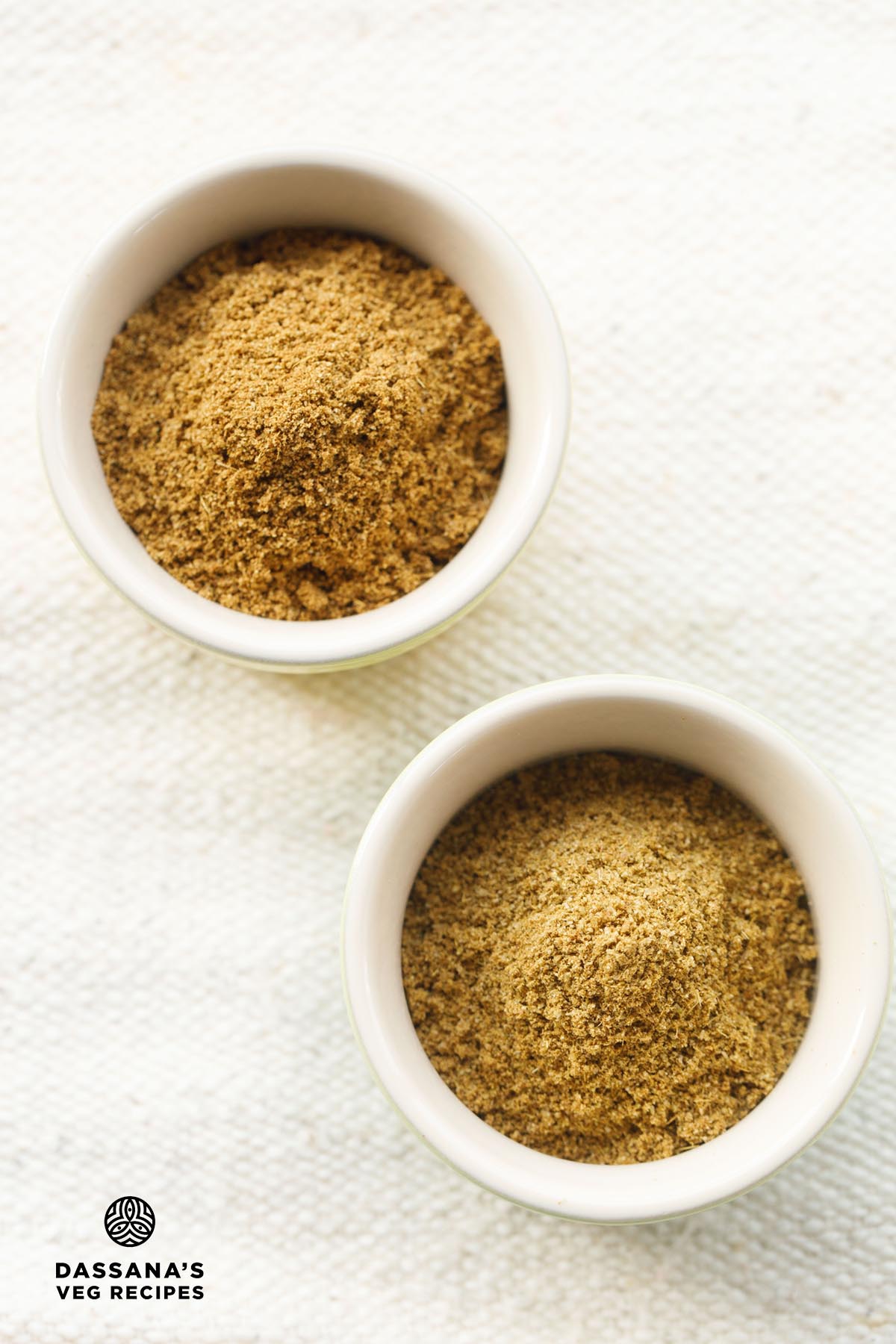

Cumin, A Kitchen Staple
Cumin seeds are tiny, boat-like seeds from the Cuminum cyminum plant. These seeds may look delicate, but they hold a powerhouse of flavor.
Ranging from light brown to golden yellow, these little seeds are often dry-roasted. Roasting them unlock their essential oils, amplifying their warm, aromatic taste.
Known as Jeera in Indian kitchens, cumin seeds have been treasured for centuries in Indian, Middle Eastern, North African, Latin American, and Mexican cuisines for their rich, earthy flavor.
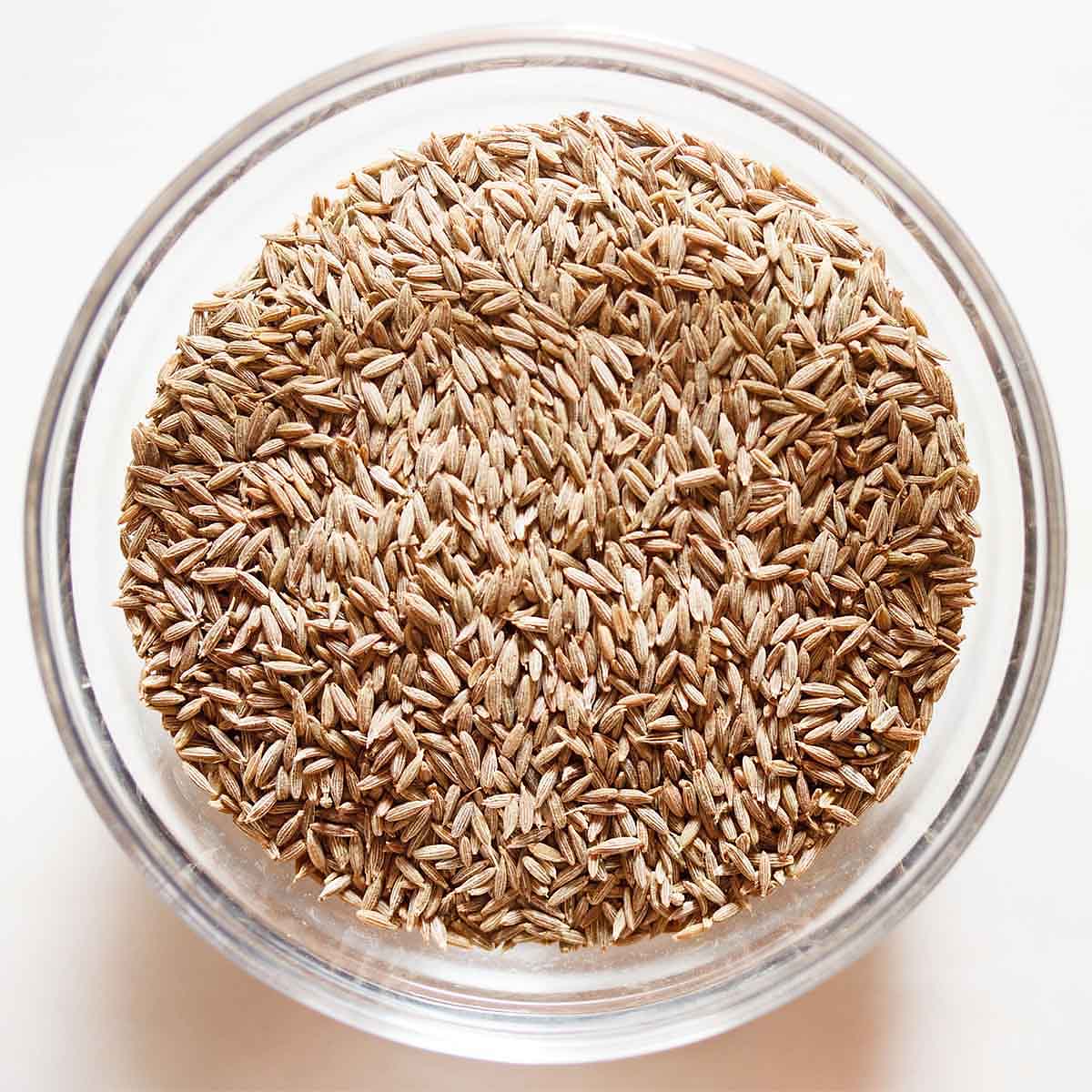

A few popular Indian dishes including cumin are Jeera Rice (fragrant cumin rice) and Jeera Aloo (savory potatoes with cumin). Another well known preparation is Jaljeera, a spiced tangy appetizer drink.
In Indian cuisine, cumin seeds are often fried in oil along with other spices and then mixed into dishes. This technique, known as tempering (tadka), involves blooming the spices in hot oil or ghee, which helps release their essential oils into the fats.
About Cumin Powder
Cumin Powder is essentially ground cumin seeds. Either you roast or sun-dry the seeds before grinding. Depending on the roasting technique, the flavor intensity varies once the cumin seeds are ground into a fine powder.
A lightly roasted Cumin Powder brings a soft earthiness that’s perfect for everyday dishes like lentils, soups, stir-fried veggies, stews, rice dishes, marinades and batters.
Meanwhile, a deeper, fully Roasted Cumin Powder (also called Bhuna Jeera Powder) delivers a bold, nutty flavor. It is ideal for elevating chaat snacks with that signature smoky warmth that pairs beautifully with tangy, spicy, sweet and savory notes.
In my kitchen, I love keeping both versions handy. One for everyday comforting meals and another specifically to capture the authentic taste of Indian street-style chaats and snacks.
I always make homemade spice blends from scratch. Whether it is Coriander Powder, red chilli powder, black pepper powder, cardamom powder etc. I have also shared some Indian spice mixes earlier like Garam Masala, Chai Masala Powder and Sambar Powder.
Why I Roast Cumin Seeds
To make regular cumin powder, I lightly roast the cumin seeds. While you can grind them raw, a light roasting helps. Since they grind more easily and result in a finer powder.
For Bhuna Jeera Powder, I roast the cumin seeds a bit longer until they release a nutty aroma and turn brown, but not burnt.
Roasting not only enhances the flavor by releasing essential oils, but it also extends the shelf life of the ground powder.
This roasting method is perfect when sunlight isn’t available or ample. That’s why I prefer roasting over sun-drying the seeds.
Ground Cumin vs Roasted Cumin
Cumin brings a cozy warmth and earthy depth to dishes, with just a hint of bitterness that lingers in the background. It’s a spice that quietly elevates everyday cooking with its subtle heat and rich flavor.
When cumin seeds are lightly toasted, they develop a soft brown hue and a mild, balanced flavor. This makes them perfect for adding gentle earthiness to dals, curries, and rice-based dishes.
In contrast, when cumin is roasted longer it turns a deep brown. As a result it delivers a more intense, smoky flavor that beautifully enhances the vibrant flavors of chaat dishes.
This transformation makes Roasted Cumin Powder a star ingredient in dishes like chaats, where the spice isn’t just a background note but a key player.
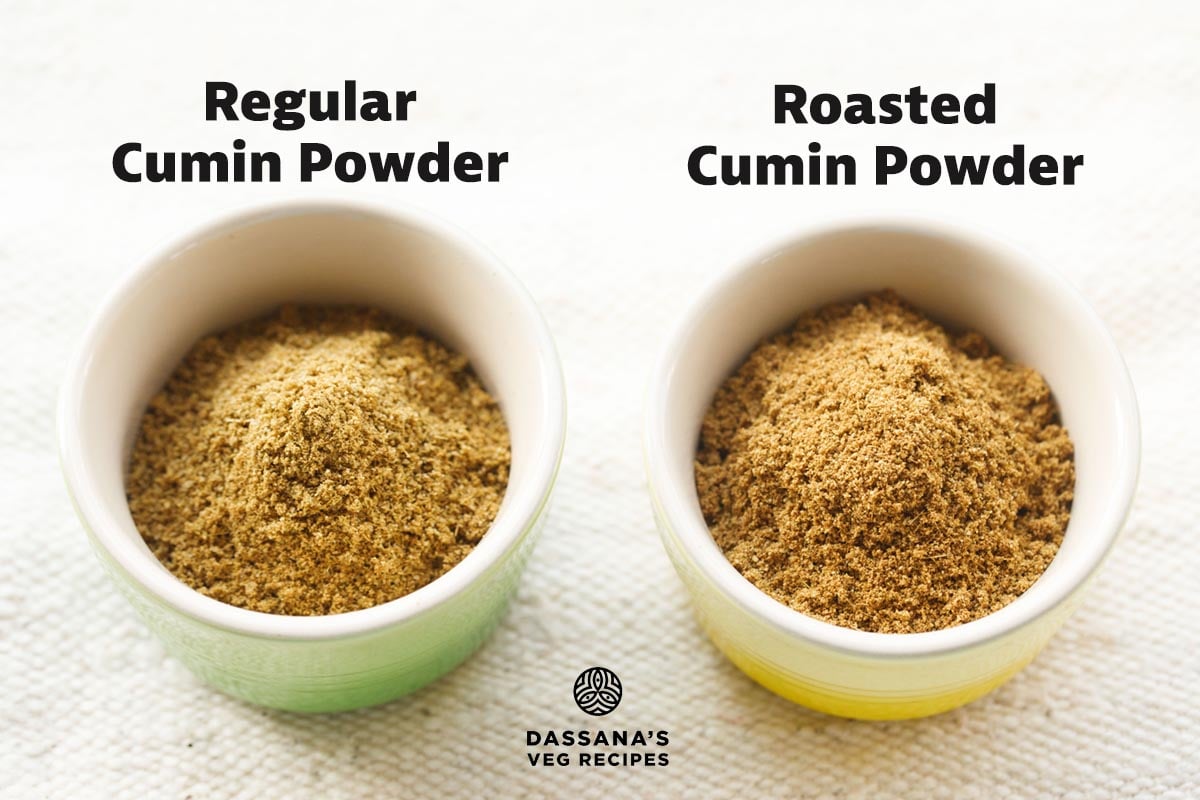

You can even tell the difference at a glance in the above image. The lightly toasted Regular Cumin Powder has a softer, lighter shade.
While the fully roasted Jeera Powder meant for chaats boasts a darker, richer brown. This is a visual cue to the depth of flavor packed inside.
Regular cumin powder is typically cooked further during the preparation of various dishes. It is often sautéed or fried along with other spices and ingredients.
In contrast, bhuna jeera powder is used as a finishing spice. It is sprinkled on snacks and chaats for its robust flavor and is not cooked.
Why Use Ground Cumin
A sprinkle of Cumin Powder can work wonders in everyday Indian dishes like dal, stir-fried vegetables, and rice preparations. It gives them a comforting, earthy undertone that deepens their overall flavor.
On the other hand, when it comes to vibrant Indian street foods like Bhel Puri, Dahi Vada, Pani Puri or Sev Puri, it’s the roasted Cumin Powder that takes center stage.
Its rich, smoky aroma and deep flavor blend perfectly with the tangy, spicy, and savory taste of chaats. Thus making it an essential part of these vibrant dishes.
That unmistakable punch of roasted cumin is what transforms a simple chaat into an unforgettable explosion of taste when paired with the tangy and spicy chaat masala powder.
Step-by-Step Guide
How to make Cumin Powder
You could roast any amount of cumin seeds depending upon your usage. I always make a small batch so that the freshness is preserved.
Roasting large quantities of cumin means that you have to store them for a longer time. This longer period of storage may reduce the potency and flavors.
It hardly takes any time to whip up a batch of freshly roasted and aromatic ground cumin powder.
To make Jeera Powder, I follow a simple but crucial process of roasting the seeds first, which enhances their natural flavors. Here’s how I prepare both types:
Roast Cumin Seeds
1. Measure ½ cup cumin seeds (60 grams), and take in a small skillet or frying pan that is heavy and thick bottomed.
Using a lighter weight pan will risk the seeds getting browned faster or burnt.
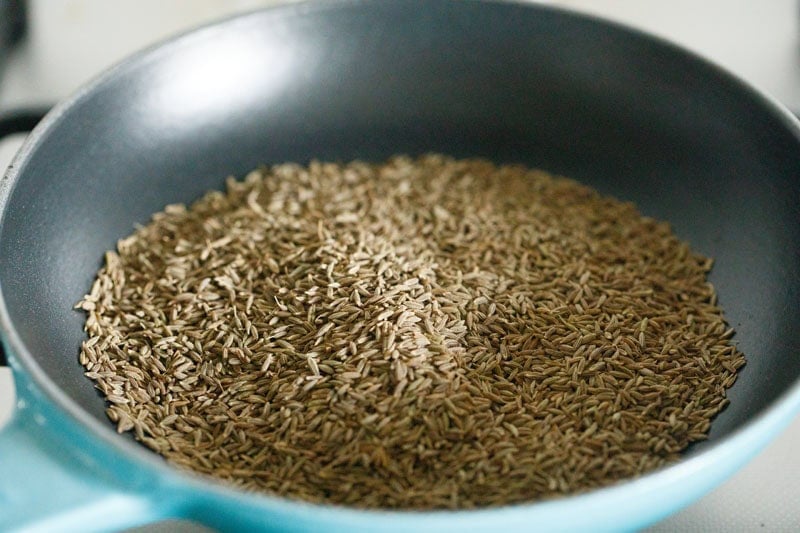

2. Dry roast the cumin seeds in a pan for 2 to 3 minutes on low to medium-low heat. Stir often for even roasting.
Adjust the heat depending on the type and quality of pan used.
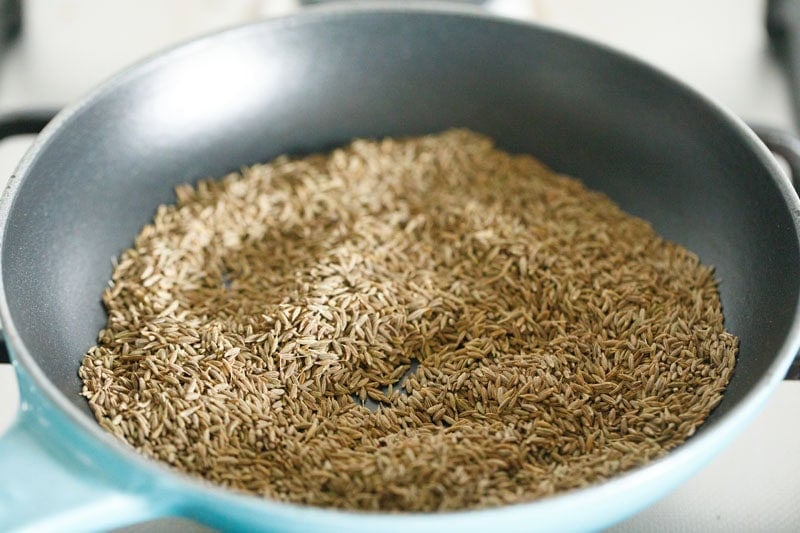

3. Switch off the heat and remove half of the roasted seeds. Set them aside in bowl, measuring cup or a plate.
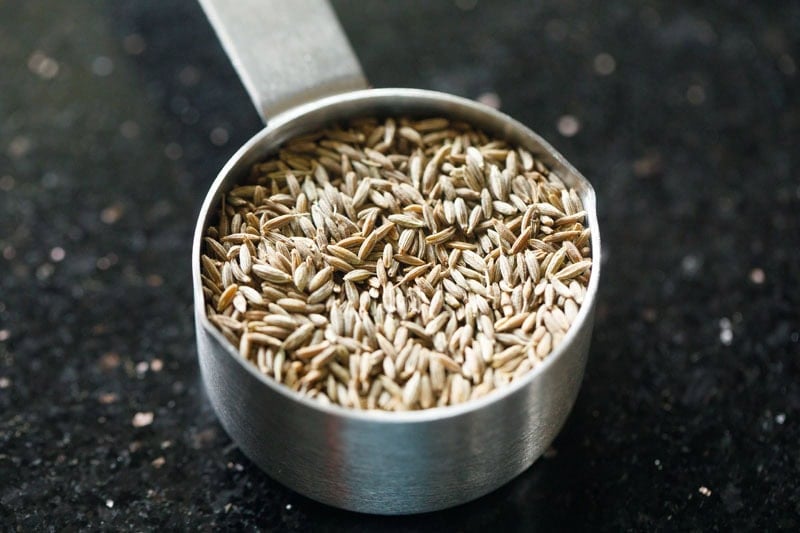

4. Switch on the heat . Continue to roast the remaining cumin seeds on low to medium-low heat stirring often.
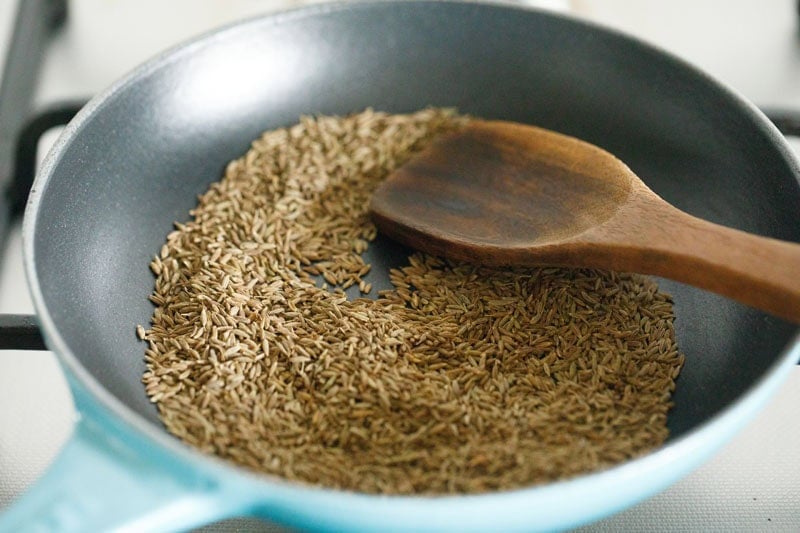

Make Bhuna Jeera
5. Roast for an additional 3 to 4 minutes on low to medium-low heat or until they are fragrant and browned. You will steam emanating from the seeds while roasting further.
Note: The process is similar to the above but for the second batch of cumin. You allow the seeds to roast until they are browned and have a rich, nutty aroma. This adds a deep complexity to chaat items.
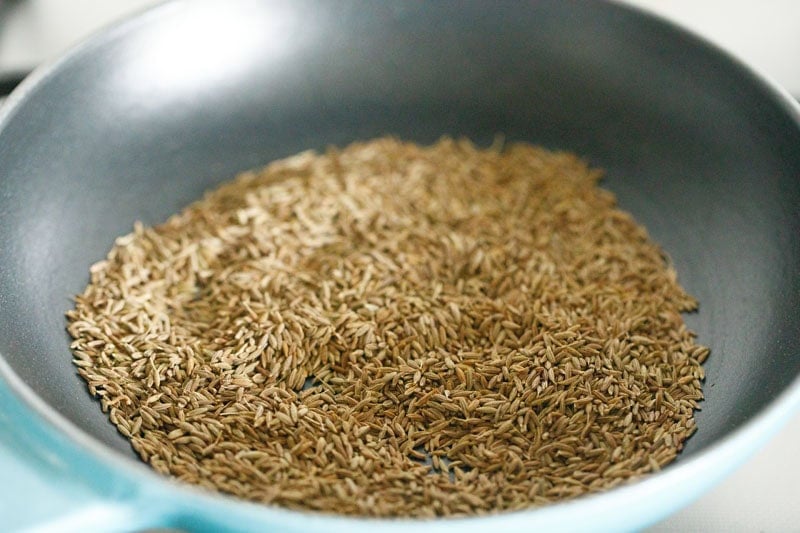

6. Transfer to a plate. Allow all the seeds to cool down before grinding.
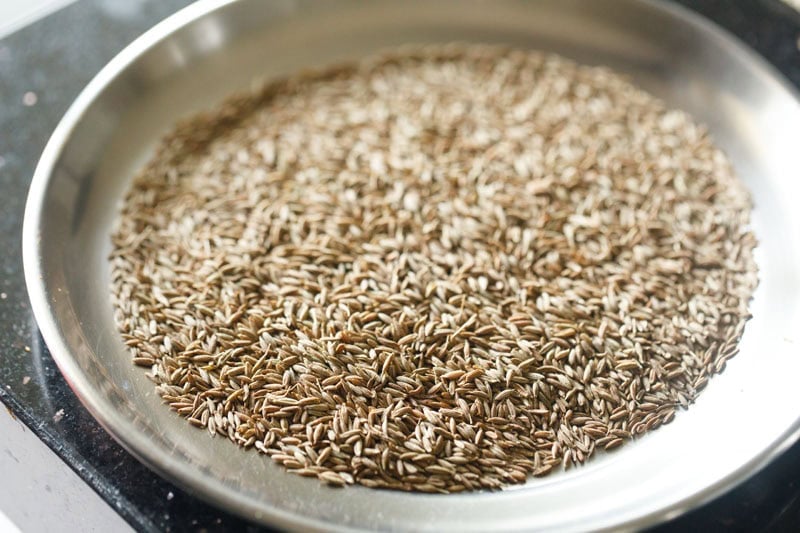

Make Regular Cumin Powder
7. Transfer the lightly roasted cumin seeds to a grinder or spice-grinder.
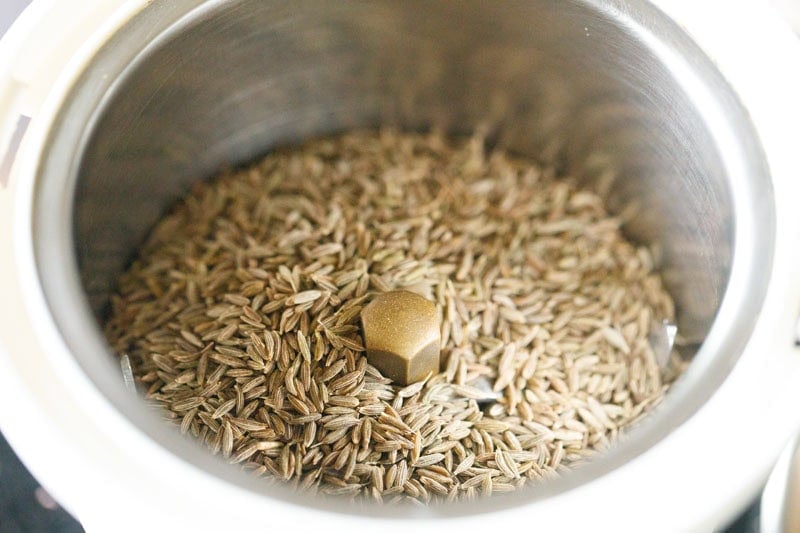

8. Grind to a fine powder. Transfer to a small spice jar or container.
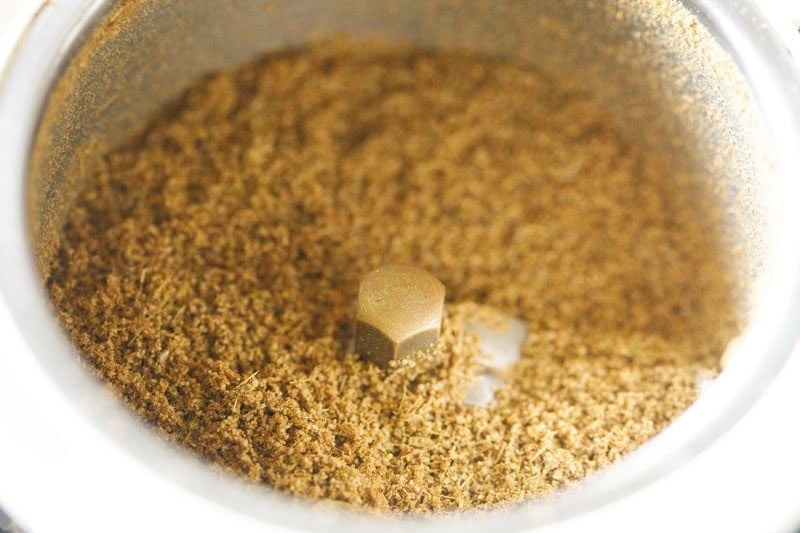

Make Roasted Cumin Powder (For Chaat Snacks)
9. Add the roasted cumin to the spice grinder or mixer-grinder.
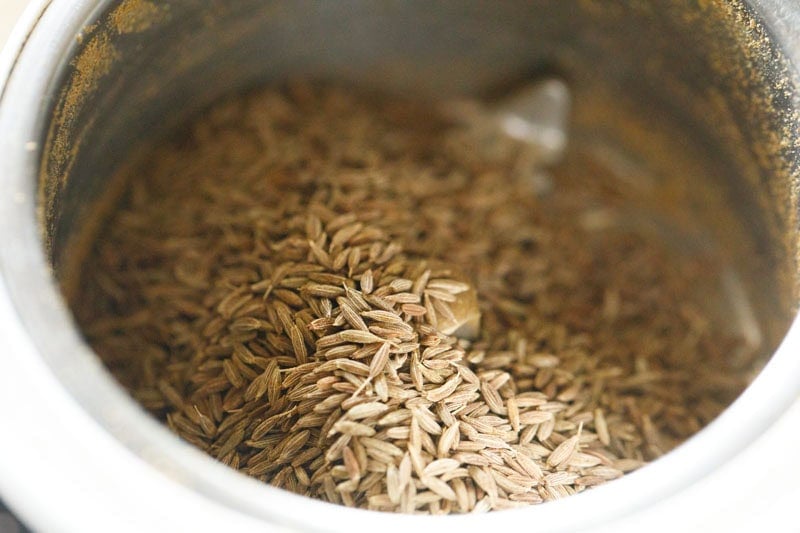

10. Grind to a fine power and transfer to a small jar or container.
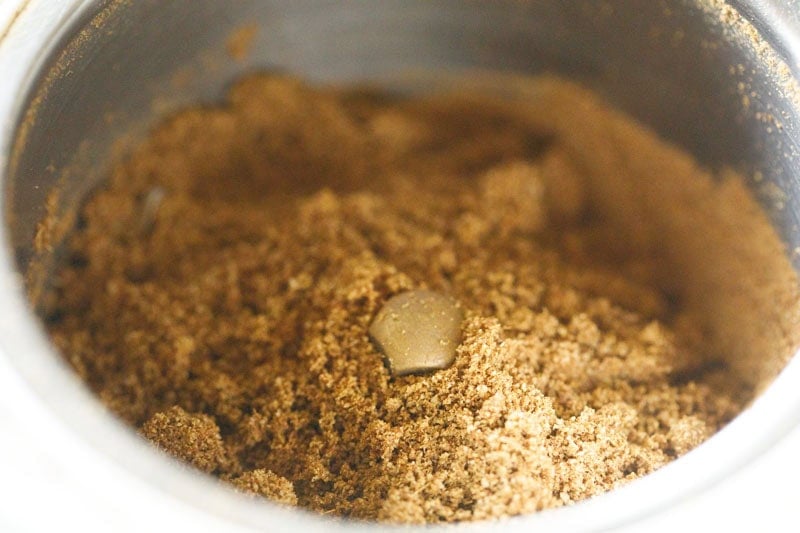

Storage Suggestions
To maintain the freshness of Cumin Powder, store it in an airtight container. It will shield it from moisture, air and light. A small glass jar or a spice container with a tight lid works best.
Store it in a cool, dry place away from direct sunlight or heat sources. A pantry or a closed spice rack is ideal. Minimize frequent opening, and if possible, use a dark-colored container to help preserve its aroma.
For the most vibrant flavor, try to use Cumin Powder within 3 to 6 months. If you’ve ground a large quantity, you can freeze a portion in a tightly sealed container.
This will keep it fresh for up to a year. Don’t forget to label it with the date so you can easily track its age.
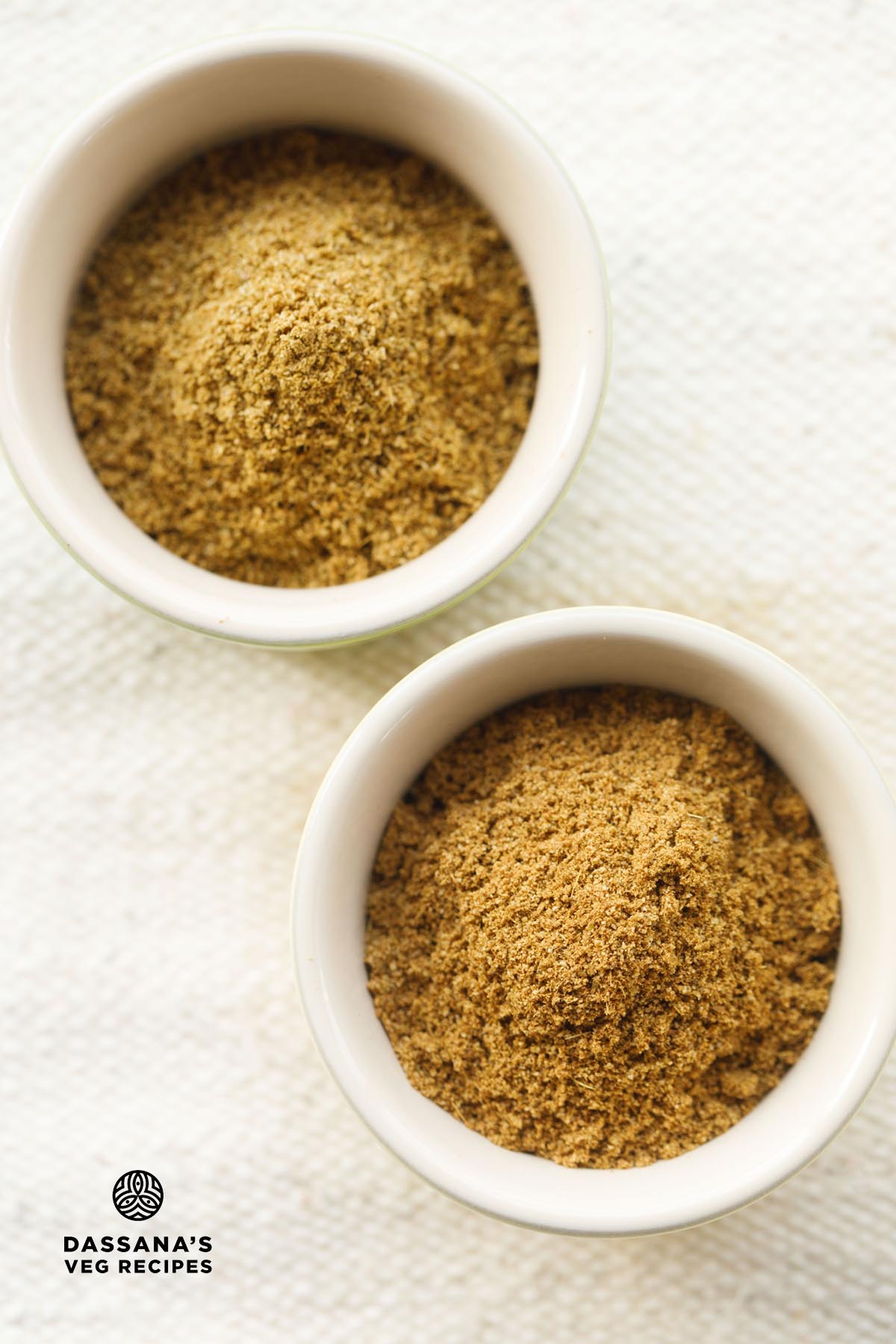

How to use
Jeera Powder is a wonderfully adaptable spice that brings depth and character to many different dishes. For everyday meals, it works beautifully in soups like a Spinach Soup, sautéed or stir-fried vegetables and rice preparations like Mexican Rice.
Its earthy warmth complements lentils, curries, steamed or roasted veggies, and even pairs deliciously with pan-fried paneer or tofu and also with snacks like Falafel and Quesadilla.
When it comes to chaat, roasted Cumin Powder is the magic touch – adding a smoky richness that perfectly elevates favorites like Ragda Patties, pani puri, sev puri, Papdi Chaat and Dahi Puri. Just a light sprinkle over your dishes or a quick stir into spice blends can make all the difference.
It’s also fantastic in raita like Cucumber Raita or Onion Raita, marinades, salad dressings and dips like Coriander Chutney, bringing an extra layer of flavor that’s subtle yet unforgettable.
I also add roasted cumin powder to Indian drinks like Nimbu Pani, Chaas (Indian Buttermilk) and Aam Panna.
One of the ways I spice up my sandwiches is by sprinkling a bit of the roasted ground cumin on Bombay Sandwich and Cheese Sandwich together with chaat masala.
Expert Tips
- Light roasting for everyday dishes: When preparing Jeera Powder for daily Indian cooking, gently roast the seeds just until they release their aroma, without letting them brown. This brings out their flavor while keeping it soft and balanced.
- Deep roasting for chaats: For chaats, roast the cumin seeds longer until they turn a rich brown. This intensifies their smoky, nutty flavor – a must-have to capture the bold essence of classic chaat dishes.
- Cool before grinding: Always allow the roasted seeds to cool completely before grinding. This step helps achieve a fine, lump-free powder with a smooth texture.
- Store smartly: To keep the Cumin Powder fresh and aromatic, store it in an airtight container, away from direct sunlight and heat. Like most spices, it’s best when its bold flavors are well-preserved.
- Grind in small batches: To maintain freshness, grind cumin seeds in small batches, especially if you’re making them in larger quantities. Freshly ground cumin retains its aroma and flavor much longer than pre-ground powder.
- Use a dry grinder: When grinding roasted cumin seeds, always use a dry grinder to ensure you get a fine, consistent powder without any moisture affecting its texture.
- Check for freshness: Cumin powder can lose its potency over time. Periodically check the aroma – if it loses its strong scent, it may be time to make a fresh batch.
FAQs
Jeera Powder made from lightly toasted seeds offers a soft, earthy flavor, perfect for everyday dishes. Roasted Jeera Powder, however, comes from seeds toasted until deep brown, creating a bold, smoky, and nutty taste that’s essential for chaats and flavorful recipes.
You can skip roasting if needed, but gently roasting the seeds enhances their aroma and flavor, making a noticeable difference, especially in dishes like chaats. It also helps the seeds grind more easily.
Properly stored in an airtight container away from heat and sunlight, Cumin Powder can stay good for up to 3 months. For the best flavor, though, try to use it within a few months.
Roasted Jeera Powder is mostly used in chaats and certain special dishes like raitas or spicy snacks where a smoky depth is desired. It’s not typically used for everyday meals like lentils or vegetable stir-fries, which usually call for regular cumin powder.
Keep the Cumin Powder in an airtight container, stored in a cool, dark place away from moisture. This helps lock in its fragrance and taste for as long as possible.
The color difference comes from the roasting time. Lightly toasted cumin seeds give a soft brown powder, while deeply roasted seeds create a darker, richer brown powder – and along with the color, the flavor also becomes more intense.
More DIY Recipes To Try!
Please be sure to rate the recipe in the recipe card or leave a comment below if you have made it. For more vegetarian inspirations, Sign Up for my emails or follow me on Instagram, Youtube, Facebook, Pinterest or Twitter.
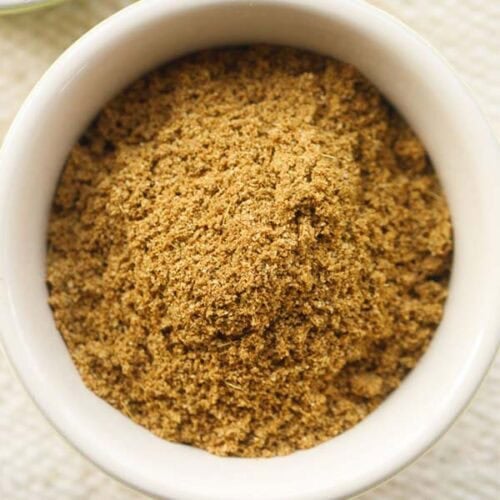

Cumin Powder Recipe (Regular & Roasted)
Cumin Powder (Jeera Powder) is made by grinding cumin seeds, either sun-dried or roasted. Lightly roasted cumin powder adds a mild, earthy flavor to everyday dishes like dals, soups, and veggies. In contrast, Bhuna Jeera (deeply roasted cumin powder) has a bold, smoky, nutty taste, perfect for chaats and tangy snacks.
Prep Time 2 minutes
Cook Time 5 minutes
Total Time 7 minutes
Prevent your screen from going dark while making the recipe
Roast Cumin Seeds
Measure ½ cup cumin seeds and set aside.
Heat a small skillet or frying pan until its hot on medium-low to medium heat. Ensure that the pan is heavy and thick bottomed.
Add the cumin seeds in the pan.
Dry roast over low to medium-low heat for 2 to 3 minutes, stirring often to avoid uneven roasting of the cumin seeds.
Turn off heat and remove half a portion of the seeds with a spoon. Set these lightly roasted cumin aside to cool.
Switch on the heat and continue roasting the remaining cumin seeds on low to medium-low heat for 3 to 4 minutes or until fragrant and browned.
Set aside these roasted cumin seeds on a plate to cool.
Make Everyday Cumin Powder
Once cooled, grind the lightly roasted cumin seeds to a fine powder in a spice-grinder or mixer-grinder.
Store in an airtight container.
Make Roasted Cumin Powder for Chaat
Storage
Store cumin powder in an airtight container in a cool, dry place.
Use within 3 to 6 months. You can also store it in the refrigerator for a longer shelf-life.
Opt to freeze for longer freshness.
How to Use
Add cumin powder to soups, lentil dishes, vegetables, rice, curries, and salads.
For chaat, use roasted cumin powder to enhance dahi vada, pani puri, bhel puri, dahi puri or sev puri with a smoky and nutty flavor.
- Roast Lightly for Everyday Use: Lightly toast cumin seeds for a mild flavor in daily dishes.
- Roast Longer for Chaat: For roasted cumin powder, toast the seeds until browned for a smoky, nutty flavor.
- Cool Before Grinding: Let the roasted seeds cool before grinding for a smooth, clump-free powder.
- Store Properly: Keep cumin powder in an airtight container in a cool, dry place to maintain freshness.
- Grind Fresh: Grind small batches to preserve flavor.

Source link